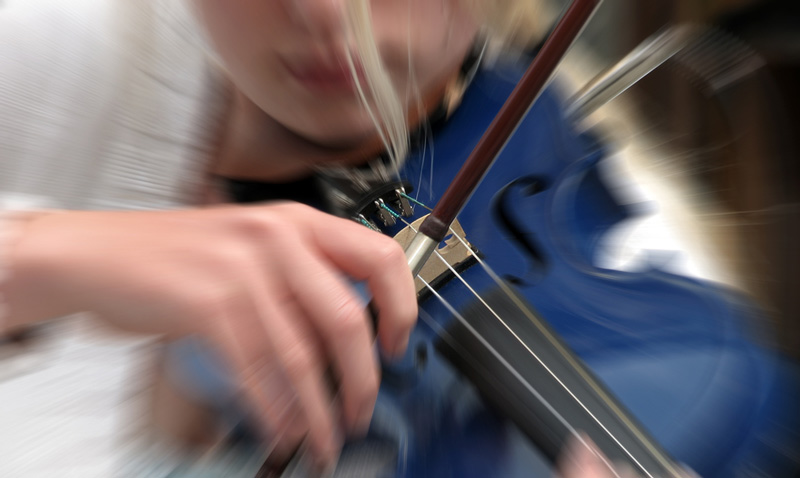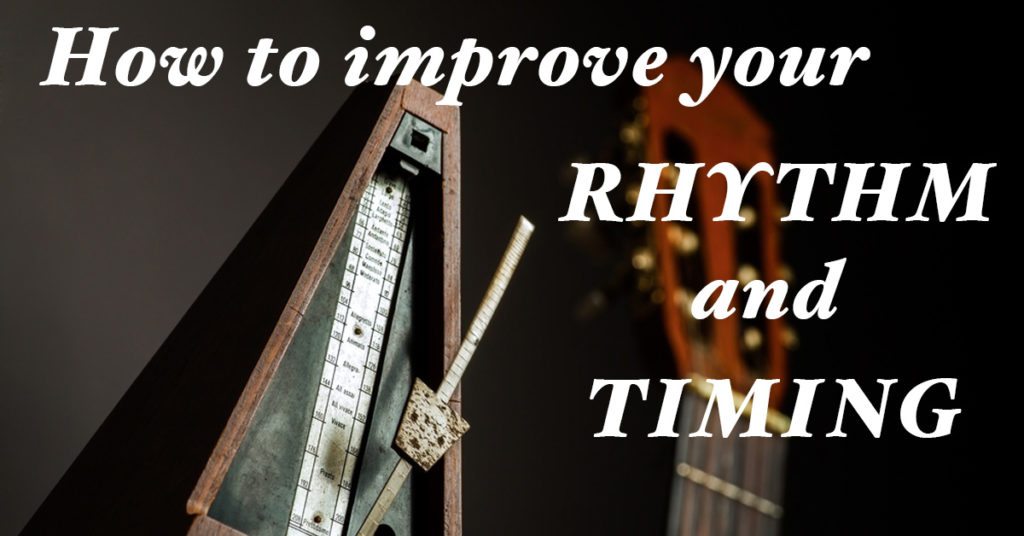Having a reliable sense of rhythm is a hallmark of any good musician and it’s one of the things which can immediately distinguish an amateur from a pro. Our sensitivity to rhythm when listening to music is subtle but powerful, and any inaccuracies quickly give the listener and uneasy sense that things aren’t working quite right.
So if you want to become a good musician it’s vital to develop your ear for rhythm and timing, and this article will help you get started.
Before we begin let’s clarify what we mean by rhythm and timing and why beginners tend to struggle with them.
In music rhythm is widely considered as the regulated succession of strong and weak elements, or of opposite or different conditions, whereas “timing” refers to the ability to keep accurately to the regular beat and synchronize with an ensemble. With such a fundamental and broad definition, hopefully you can see why having a strong sense of rhythm isn’t just for the drummers!
Musicians primarily fail with these two because they don’t match the level of their skills with the complexity of composition they chose to play. This can lead to the feeling that performing live with good rhythm is extremely hard.
The truth is, each piece may feel complex at first, but becomes easier with practice. Let’s look at some useful tips for how you can improve your rhythm and timing when playing music.
Where to start?
It’s important to start practice with appropriate compositions. The best melodies for practicing are usually within one octave, in a key signature you’re familiar with. Also it is best if there are not any sixteenth or thirty-second notes (a.k.a. semi-quavers or semi-demi-quavers), so the pattern is not too complicated at the correct tempo. Here are a couple of easy to understand examples for you to try playing along with:
Whether you are experienced musician or amateur your rhythm practice should always start with careful study of the piece, slowly playing each note. If there is some complex rhythmic pattern ahead, don’t try to play it perfectly first time you come across it. Leave it and then try to practice it in isolation. The first time you play it you want to make sure you hit the right notes; leave the timing and rhythm as secondary priorities. That way you can have your full attention ready for working out the rhythm when you return to it.
Techniques for Improving Your Rhythm and Timing
We’re going to look at four techniques you can start using today to improve your sense of rhythm and timing when you play music. Try to incorporate one or more into your regular practice immediately and then add the others over time.
1. Counting and Slow Tempo
When you want to perform specific compositions, you have to remember that they have been written with a specific tempo. This means it is expected that you play them at that same tempo as well. To do this it’s recommended that you practice with a metronome.
If you don’t have sheet music (e.g. you’re playing by ear) you can Google the original song and figure out what BPM it was recorded at. Set up your metronome to that particular tempo and count along with the particular time signature. Most common time signatures will count up to four in each bar, but you might find some counting to 3, 5, or 6 for example.
When you are familiar with counting, leave the metronome ticking and try to play along your instrument. You may find it helpful to tap each beat with your foot, so you can continue “counting” even as you play.
You normally start on the first beat as most pieces will start on “1”. If you want you can also play the original track in background as a reference to make sure your rhythm and timing is correct, though this requires careful synchronisation of metronome with recording.
If you are finding the rhythms challenging to play in time, reduce the tempo on the metronome. You keep counting in exactly the same way but it should be easier to get each note perfectly in time. Then as you practice and improve you can gradually increase the speed of the metronome beat until you reach the target tempo.

You can learn more about this in the article “Improved Practice: Slow Down to Speed Up”.
2. Record and Play Back
When you feel you are getting better, try to play your instrument without the original song or metronome on. If you still feel you need some rhythm reference, try to tap your foot quietly or gently move your head just to feel the tempo better. You have probably seen many professional musicians do this when performing live. It helps you keep a sense of accurate timing even when you aren’t playing frequent notes.
Now take a sound recorder and record your performance. When you are finished, enable the metronome again and play back your recording in synch with it. Pay attention to the parts with complex rhythms and their timing, as those are usually the ones which will take time to master. If the ticking of metronome stays in sync from start to end, you can tell that your timing is good. If you hear each note appear exactly when it should compared with the steady beat you know you have good rhythm. For extra confirmation you can compare your recorded performance with the original song recording.
If you identify any inaccuracies or sections which sound “loose” or unsteady, don’t ignore them! Go back and practice those sections in isolation, using the “slow tempo” approach described above. When you can nail the rhythm reliably, increase the tempo until you can nail it every time at full speed. Then try recording your full performance again to check you have resolved the problem.
3. Divide the Beat
Professionals who want to make sure their rhythm and timing is perfect use a simple technique called “beat dividing”. This time no metronome is involved, because as name describes, the regular tempo of the beat is simply divided further.
What it means is that even if the beat is a simple “1, 2, 3, 4” you instead count (in your head) something like “1 and 2 and 3 and 4 and” or even “1 e and a, 2 e and a, 3 e and a, 4 e and a”. These represent dividing the beat in half or in quarters, respectively. Or you might count triplets as “1 and a 2 and a 3 and a 4 and a”.
What’s the advantage? Well, it means that even if almost all notes arrive simply on the beat (i.e. 1, 2, 3 or 4 in our examples), when one does appear in between beats you’ll know exactly where to place it.
Without subdividing the beat like this, you just have a big empty space between each beat and it’s difficult to be accurate about placing notes. With subdividing you are essentially creating a lot more markers during each bar which let you place notes in exactly the right places between beats.
This technique is also often done in Digital Audio Workstations, where beats are divided digitally and notes you are playing are being recorded as visual arrangements on screen. You can divide any beat into 4, 8, 16, 32 or even 64 parts, so this technique gives you maximal control on your timing. This is a great technique for artists performing compositions with lots of short notes or very intricate rhythms.
4. Practice rhythm and timing on different instruments
Another thing to keep in mind is that rhythm and timing practices may differ from instrument to another. To give you an idea, let’s look at a couple of examples on common instruments.

If you have a complex song on piano, it is recommended to start with the left hand part, as it is usually easier and gives you a structure for the progression of the composition. When you have mastered the left hand, it’s time to focus on the melodies in the right hand. The right hand usually has much more complex rhythm and timing, so pay attention to this. After you have mastered each part individually, try to put both together using techniques described.
Another example would be if you are a guitar player. When you start with a new piece you should aim to master the rhythm for right hand to feel the strumming pattern. Then after that it would be recommended to study the chords and/or melodic riffs for the left hand.
For many other instruments an approach as described in the “Where to start” section above should be useful, meaning separate out the rhythmic challenges from the pitch challenges. You can play through the piece ignoring complex rhythms to begin with, just aiming to play the correct notes, and introduce the rhythms later. Or you might prefer to clap through the rhythm of the piece before you pick up your instrument so that you’ve deciphered the rhythms and mastered the timing before you worry about which notes to play.
Another thing to mention here is that in spite of these differences, rhythm and timing skills are actually shared across instruments, so when you improve your ears for rhythm and timing on one instrument you will find it much easier to tackle complex pieces on another instrument, as your ability to read rhythms and internal skill for reproducing them will transfer directly across.
Keep Rhythm and Timing in Mind
Rhythm and Timing are so fundamental to music that they are skills you will be continually honing and developing as you improve as a musician. Don’t expect overnight mastery, but do keep them “front of mind” whenever you practice music.
Depending on their rhythmic complexity, it may take several months to master some compositions. Although rhythm and timing are considered basic skills, you must adapt to different compositions and their unique rhythmic challenges.
Some people have a great sense of timing and rhythm from early on. Others have to work doubly hard to produce the same results. Be patient and practice day by day every time you play your instrument. Use the four techniques above and keep rhythm and timing front of mind and you will see fast progress!







